Traditional Chinese Clothes is an integral of the thousands-year-old Chinese civilization. It changed along with the political, economic, and social changes in different eras and dynasties. The elegant Pao costume (a closed full-body gown) of Qin and Han dynasties, the Shan costume (open cross-collar shirt) in Wei and Jin dynasties, the open-style clothes of Tang dynasty, and the Manchu style clothes in the Qing dynasty, each had its unique characteristics and formed an important part in Chinese Costume.
In Xia, Shang, and Zhou dynasties, the top Yi (a narrow-cuffed, knee-length tunic tied with a sash) and bottom Shang (a narrow, ankle-length skirt) style of clothing with a right lapel were prevalent. Some people also wore Shenyi, one-piece robes that wrap around the body once or several times. 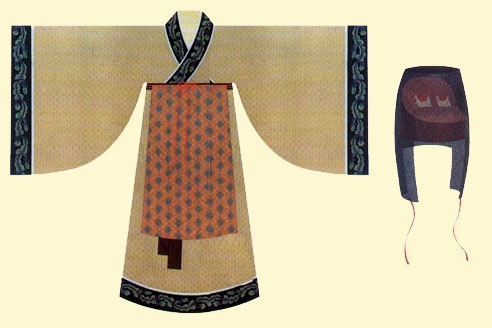 The slave owner statue unearthed in Anyang, Henan wore a flat hat, a tunic with cross collar, a skirt with a sash, puttees on both legs, and protruding pointed shoes, which could show how Shang dynasty people dressed.
The slave owner statue unearthed in Anyang, Henan wore a flat hat, a tunic with cross collar, a skirt with a sash, puttees on both legs, and protruding pointed shoes, which could show how Shang dynasty people dressed.
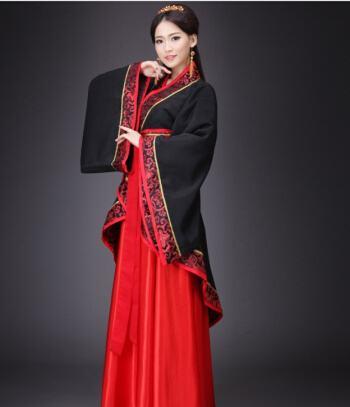 Warring State Period (771 B.C - 221 B.C)
Warring State Period (771 B.C - 221 B.C)
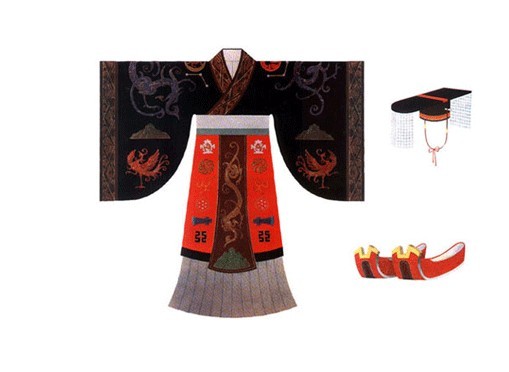 The collars were usually crossed either from left to right or otherwise, and the neckline was quite low, making the inside garment revealing. The working women often wore short garment on top and long skirt at the bottom with a belt on the waist.
The collars were usually crossed either from left to right or otherwise, and the neckline was quite low, making the inside garment revealing. The working women often wore short garment on top and long skirt at the bottom with a belt on the waist.
The men's clothes were still similar to previous clothes. The most popular clothes for them were robes, which could be divided into curving-front robes and straight front robes. Like the women's clothes, men's robes also had belts, the difference lies in that men's clothes had leather belts with belt hooks, while women's clothes only had a silk sash. The black color was the distinguished color back then. Thus, many imperial clothes were fashioned in black color. In the Han dynasty, the clothing styles were similar to that of the Qin dynasty. However, the advancement of dyeing and weaving techniques greatly improved the quality of clothes.
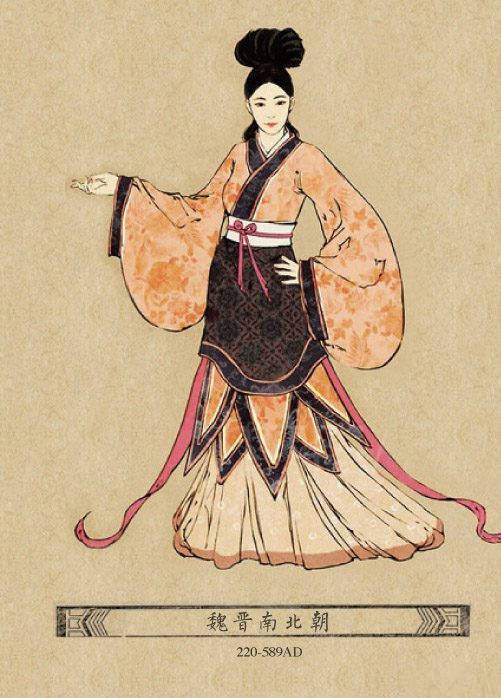 Dynasties (220 A.D - 589 A.D)
Dynasties (220 A.D - 589 A.D)
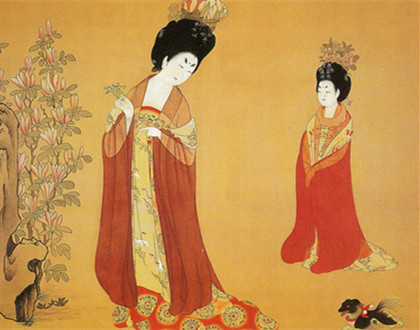 Besides, there were other styles of gowns like Lan Gowns (closed, round-collared robes) and Gowns without Crotch. These new styles of clothes were mostly influenced by Hufu and transformed by combining the habits and etiquette of the Han people.
Besides, there were other styles of gowns like Lan Gowns (closed, round-collared robes) and Gowns without Crotch. These new styles of clothes were mostly influenced by Hufu and transformed by combining the habits and etiquette of the Han people.
While the women's clothing in Tang dynasties was one of the kind among the Chinese clothes. It had bright colors, graceful styles, and gorgeous decorations and accessories. For example, besides the garment and skirt, there was a long Pei (embroidered cape), and the special short-sleeved garment that could be worn outside the long garment. Such kind of dressing helped to form the extremely open clothing styles of low-cut collar, bare-armed large sleeves, mantilla, and long skirt.
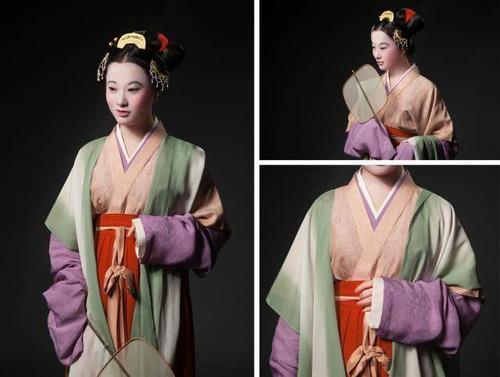 the natural justice and destroying the human desires" were greatly advocated. These philosophical concepts imposed an impact on people's dressing. Unlike the open and luxurious clothing style in the Tang dynasty, Song era clothing became very conservative, serious, and single-colored. Meanwhile, the constant threatening from the northern borders and the incompetence of Song emperors had made the country weak and poor. Therefore, the rulers demanded common people to refrain from extravagance and wear simple clothes. Thereby, the simple and plain style of clothing was popular at that time.
the natural justice and destroying the human desires" were greatly advocated. These philosophical concepts imposed an impact on people's dressing. Unlike the open and luxurious clothing style in the Tang dynasty, Song era clothing became very conservative, serious, and single-colored. Meanwhile, the constant threatening from the northern borders and the incompetence of Song emperors had made the country weak and poor. Therefore, the rulers demanded common people to refrain from extravagance and wear simple clothes. Thereby, the simple and plain style of clothing was popular at that time. 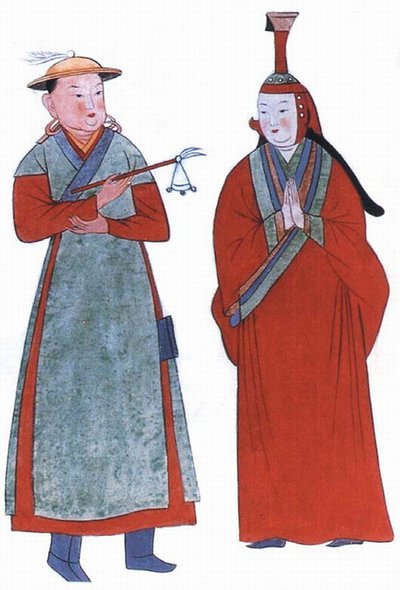 Yuan Dynasties (916 A.D - 1368 A.D)
Yuan Dynasties (916 A.D - 1368 A.D)
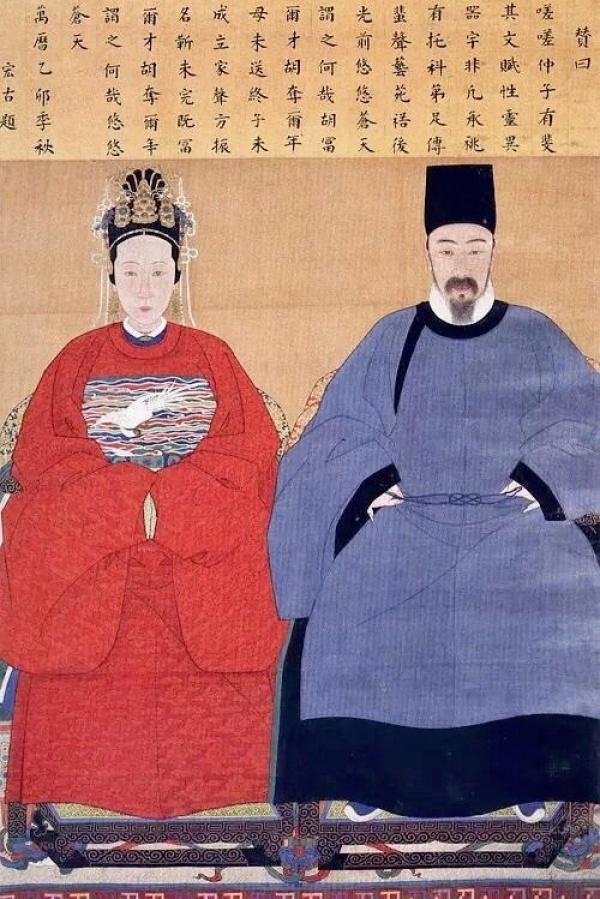 clothing and re-adopting the Hanfu of Zhou, Han, Tang, and Song dynasties were made. The regulation had stipulated the Mianfu (religious court dress of emperor) and everyday court dress for emperors, the formal dress and everyday dress of empresses and concubines, the Chaofu (ceremonial court dress), and everyday dress for ministers and officials, and the Jinfu for ordinary people. The opera costumes today are mostly modeled after the Ming clothes. There were many kinds of clothing materials in the Ming dynasty and embroidery technology was quite developed.
clothing and re-adopting the Hanfu of Zhou, Han, Tang, and Song dynasties were made. The regulation had stipulated the Mianfu (religious court dress of emperor) and everyday court dress for emperors, the formal dress and everyday dress of empresses and concubines, the Chaofu (ceremonial court dress), and everyday dress for ministers and officials, and the Jinfu for ordinary people. The opera costumes today are mostly modeled after the Ming clothes. There were many kinds of clothing materials in the Ming dynasty and embroidery technology was quite developed.
Therefore, patterns of animals and plants were very common in clothes, especially the official's formal clothes. Different patterns represented different ranks in governmental positions. The everyday clothes for men were Zhiduo (similar to a Zhiju shenyi but with vents at the side and 'stitched sleeves'), Daopao (priest robe), and Pleat Garment. While everyday clothes for women were garments, coats, embroidered vests, cloud shoulders, paddy field garments, and skirts.
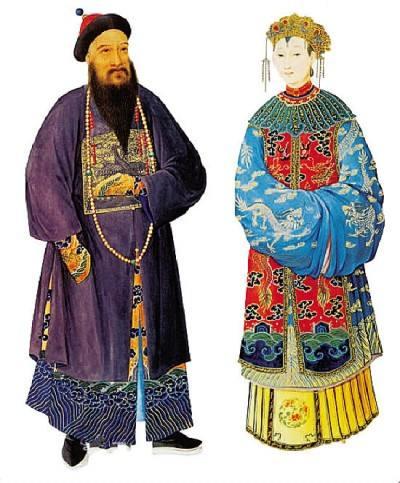 Due to the widespread resistance to the Queue Order, Qing rulers allowed women to retain their hairstyles and just change their clothes to Manchu styles, which later became Qipao. For men, there were Manchu national clothes and western clothes two kinds. The Qing era robe styles were developed based on the Manchu traditional robes and absorbed the essence of Hanfu.
Due to the widespread resistance to the Queue Order, Qing rulers allowed women to retain their hairstyles and just change their clothes to Manchu styles, which later became Qipao. For men, there were Manchu national clothes and western clothes two kinds. The Qing era robe styles were developed based on the Manchu traditional robes and absorbed the essence of Hanfu.
Generally speaking, the robes at this time had narrow sleeves, small buttons on the middle of the front garment, or the right lapel to fasten the robe, and around collar. The imperial robes were composed of four pieces of fabrics while the ordinary robes only have two pieces of fabrics. Round collars were very popular, but piwa collars also existed. In the late Qing dynasty, western clothes were brought into China. The traditional Chinese costumes thereby entered modern times. In the Republic of China, the traditional Hanfu was revived on small scale. Most people wore Zhongshan suits, Qipao, and long robes with a coat.
Copyright © 2019 Lily Sun China Tours International, Inc. Terms &conditions | Privacy Policy | Sitemap